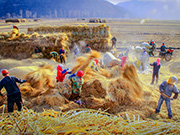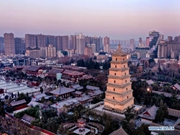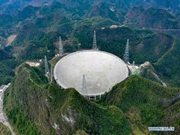


The Kubuqi Desert is turning into an oasis. [Photo by Tanja Herko]
A green name card to the world
In just 30 years, the Kubuqi Desert greening project has succeeded in not only reining in the relentless growth of the seventh-largest desert in China, roughly the size of Kuwait, it has also turned about 6,000 square kilometers of the desert - roughly one-third of it’s entire size - green.
Due to its impressive results, the Kubuqi desertification control model was named by the United Nations as a "global ecological and economic demonstration zone" in 2014, while Ordos has been host to the Kubuqi International Desert Forum every two years since 2007.
“Government policy support, the market-oriented participation of residents, as well as ecological improvement as a result of investment and new technology, have been vital to the success of the Kubuqi model,” said Hao.
Ordos’ success has attracted many politicians and experts around the world, who come to China to find a remedy for their desertification problem. Abdushukur Khudoykulovich, deputy chairman of the state forestry committee of Uzbekistan, who also joined this year’s Kubuqi International Desert Forum, noted that his country could learn from the Kubuqi model to tackle environmental issues.
“Half of Uzbekistan territory is occupied by desert zones, not to mention that the Aral Sea, which was there 30 years ago, has now been engulfed largely by deserts. We are now trying to tackle the spread of deserts. China’s experience can enlighten us more,” said Abdushukur.
“Desertification and drought are our common enemy that has threatened our social and economic development. The world should work together to tackle such issues, and I believe China has served as a great model for us all,” he added.
 |

 Award-winning photos show poverty reduction achievements in NE China's Jilin province
Award-winning photos show poverty reduction achievements in NE China's Jilin province People dance to greet advent of New Year in Ameiqituo Town, Guizhou
People dance to greet advent of New Year in Ameiqituo Town, Guizhou Fire brigade in Shanghai holds group wedding
Fire brigade in Shanghai holds group wedding Tourists enjoy ice sculptures in Datan Town, north China
Tourists enjoy ice sculptures in Datan Town, north China Sunset scenery of Dayan Pagoda in Xi'an
Sunset scenery of Dayan Pagoda in Xi'an Tourists have fun at scenic spot in Nanlong Town, NW China
Tourists have fun at scenic spot in Nanlong Town, NW China Harbin attracts tourists by making best use of ice in winter
Harbin attracts tourists by making best use of ice in winter In pics: FIS Alpine Ski Women's World Cup Slalom
In pics: FIS Alpine Ski Women's World Cup Slalom Black-necked cranes rest at reservoir in Lhunzhub County, Lhasa
Black-necked cranes rest at reservoir in Lhunzhub County, Lhasa China's FAST telescope will be available to foreign scientists in April
China's FAST telescope will be available to foreign scientists in April